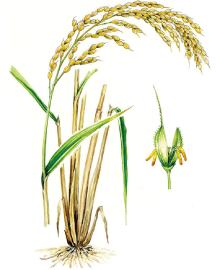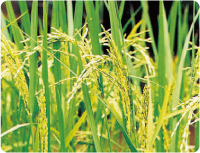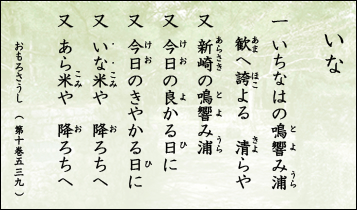Traditional Okinawa Village and Omoro Arboretum
Oryza sativa
General description

| Omoro name | Ina |
|---|---|
| Japanese name和名 | Ine |
| Family name | Poaceae |
| Okinawan name | Unni |

Location within the park

Characteristics
The stem of Oryza sativa branches off at the root and grows to be 20 to 35.5 inches tall. One spikelet grows on the tip of each twig that branches off. This panicled inflorescence is the so-called ear of rice which stands upright during the flowering season but hangs down by its own weight as the rice becomes ripe. Although Oryza sativa is essentially an aquatic plant and is mainly paddy rice that is cultivated in paddy fields, there is also floating rice that grows in deep water and dry-land rice which can be grown with little water. Although rice seedlings of paddy rice are transplanted to the main rice field during the rainy season and harvested around October in central Japan, in Okinawa, seeds are planted in February and harvested in July for the first crop, and planted again in July and harvested in November for the second crop.
Utilization
【fruit】 : Staple food, Ingredient for rice cake, Refined flour, Sweets, Starch, Japanese sake, Miso, Basic ingredient for soy sauce
【culm】 : Rope, Straw sandals, Tatami flooring, Feed, Fertilizer
Best Time To See Calendar

Omorosaushi (539 of Volume 10) Ina

Meaning of the song
The appearance of the famous beach of Ishikinawa
excited with joy is splendid
The appearance of the famous beach of Arasaki
excited with joy is splendid
On this good day
On this glorious day
Unload the rice
And unload the new rice
and become prosperous








